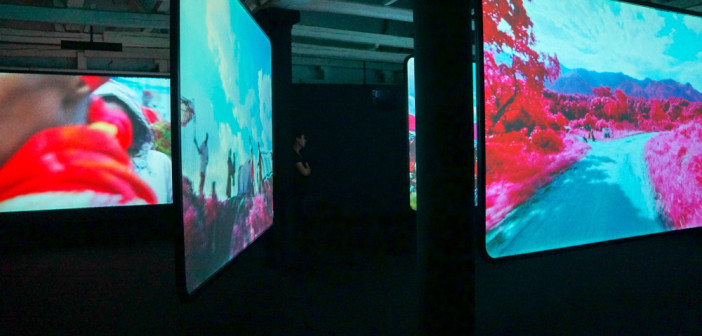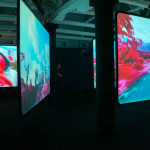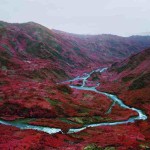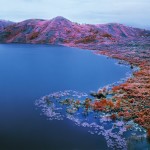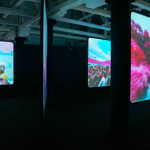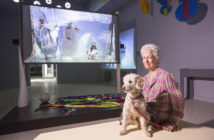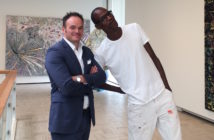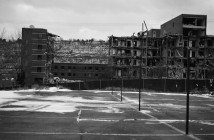An enclave is the term for an isolated land or group which is wholly surrounded by another and thus inaccessible without passing through foreign territory.
I’ve come to Venice Biennale to see the best of what the international art scene has to offer, and I’m not disappointed. After days of walking around Venice to see as many of the 88 countries and 47 collateral exhibits as humanly possible, by the last day my feet are just band-aids. However, I’ve been seeing intriguing posters from an exhibit my map tells me is not far from where I‘m staying, and I can’t go home without checking it out.
In shades of otherworldly pink, like Dr. Seuss’ Truffula trees come to life, the shiny wall-sized prints in the first room of the Irish Pavilion present a lush and epic landscape that is familiar in form despite its unusual palette. The exhibition --and the pink--continues in the next room where approximately 40 minutes of film on six screens present different storylines simultaneously, united by one soundtrack. It is The Enclave.
Irish artist Richard Mosse, together with sound designer Ben Frost and cinematographer Trevor Tweeten, travelled to the Democratic Republic of Congo to create this artistic record of a conflict that is so violent and dense that it has defied traditional reporting. There is no sound bite adequate to explain what life is like in DR Congo.
Mosse’s tools are designed to reveal the unseen; his large format camera and the now-discontinued Kodak Aerochrome infrared film was previously used by the military to detect the camouflage of soldiers within a green landscape. The images of conflict and suffering in Africa we are familiar with have been documented in a way that is true to our expectations of reality. In The Enclave, Mosse presents us with a sight unusual to eyes that perceive only a slice of the full spectrum of light, a seductive vision but not an untruthful one. The infrared color here multiplies the strangeness, challenging us to look beyond what is foreign to reveal the human nature camouflaged within. Here is the case where fidelity is not truth.
The Democratic Republic of Congo has the most natural resources of any country in the world. Since the arrival of the Belgians in 1885, Congo has been plundered by foreign and domestic powers. Today, with untapped mineral assets estimated at 24 trillion dollars, it may be another century before we see the end of "the vilest scramble for loot that ever disfigured the history of human conscience."
The DR Congo is hardly less violent or chaotic now than when it inspired Conrad’s Heart of Darkness. The UN estimates that as many as 45,000 people die each month in the Congo due to violence or other indirect factors of the current conflict. More than 40 different rebel groups of several nationalities live within the Congo, terrorizing the people and exploiting Congolese resources, (such as coltan, a material critical to cellphones and other electronics.)
Unfortunately, these resources have been anything but a boon to the average DR Congo citizen, who is among the poorest in the world. As of 2013, there are 2 million Congolese people categorized as "internally displaced persons" --people who have been forced from their homes to live in makeshift camps due to violence and other human rights violations.
It is primarily these two groups-- rebel soldiers and the IDPs (many of whom are children) that are juxtaposed within The Enclave. Like the surreal Truffula-esque trees in the background, the scenes of brutality, suffering, and resilience are so indescribably removed from my daily reality of smartphones, Starbucks, and ergonomic chairs that I struggle to decipher what I am seeing.
The Enclave offers no answers, no simple Seuss-ian "Unless," just a masterfully executed way to keep from forgetting the frail pink humanity unseen behind the black and white headlines.
- The Enclave. Installation at the Venice Biennale’s Irish Pavilion. Photo by Stephanie Arnett.
- Richard Mosse, Love Is The Drug, South Kivu, Eastern Congo, 2012digital c-print, 279 x 533 cmCourtesy the artist and Jack Shainman Gallery, New York.
- Richard Mosse, Beaucoups Of Blues, North Kivu, Eastern Congo, 2012 digital c-printCourtesy the artist and Jack Shainman Gallery, New York.
- The Enclave. Installation at the Venice Biennale’s Irish Pavilion. Photo by Stephanie Arnett.
The Enclave runs through November 24th at the Pavilion of Ireland, at Fondaco Marcello, San Marco 3415 (Calle dei Garzoni), 30124 Venice Italy. The Enclave has also been published in book format by Aperture.

